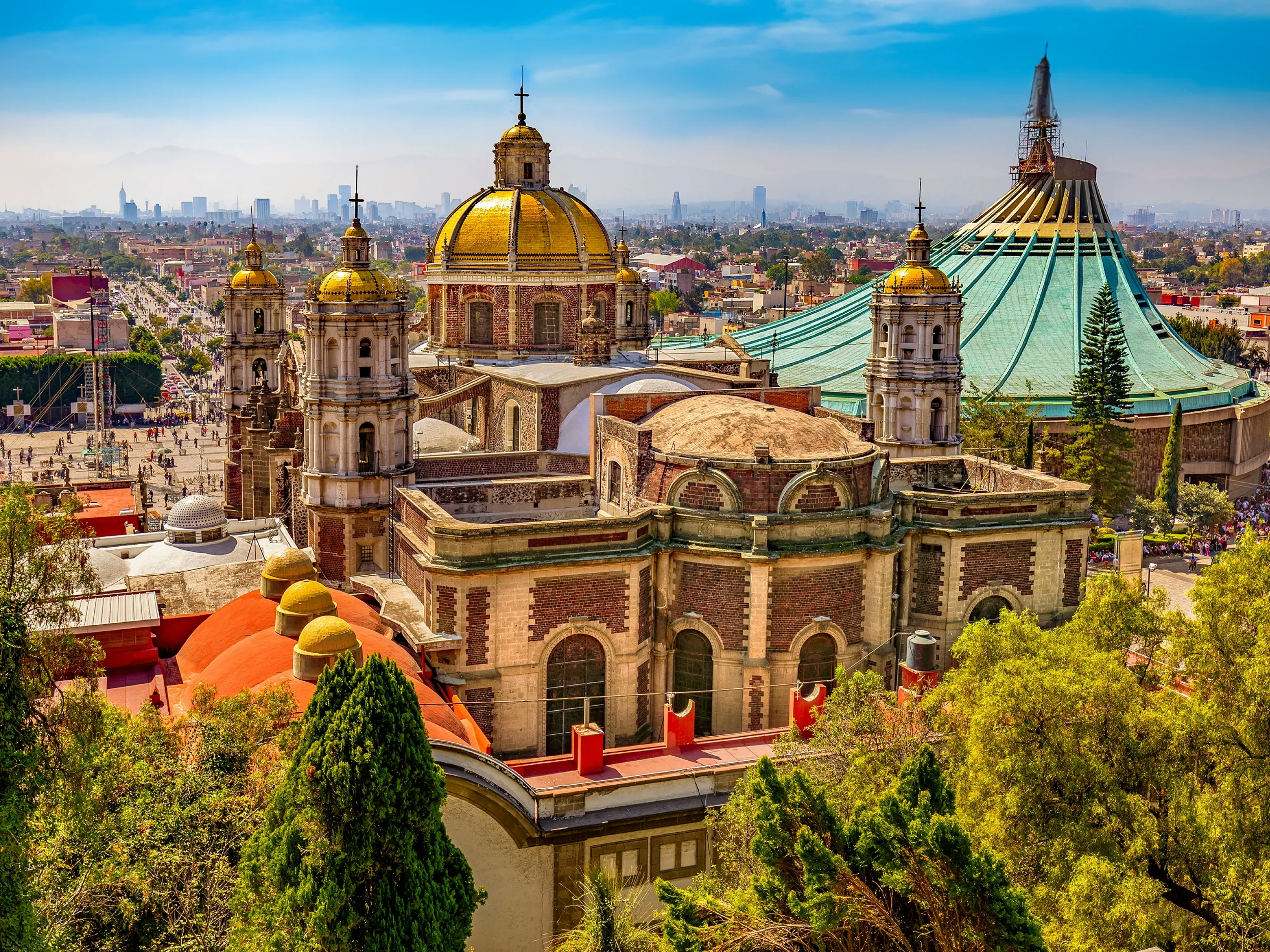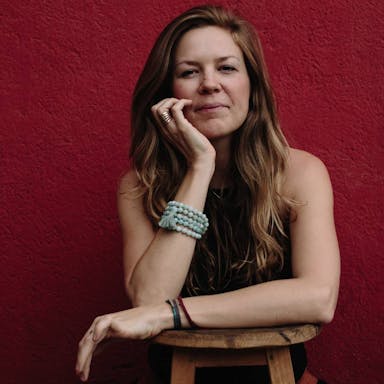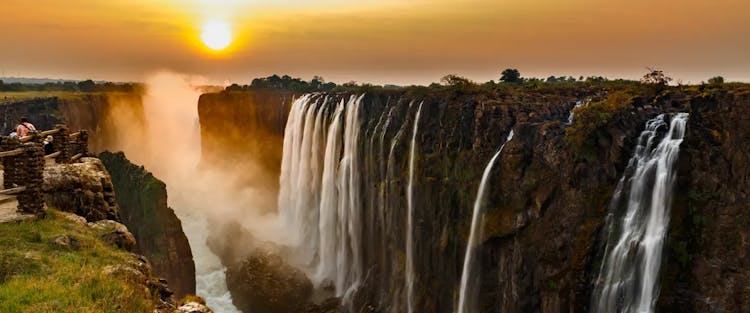
Mexico City: The Mexican Capital with 150+ Museums—and Almost As Many Types of Tacos
Mexico’s capital, Mexico City, is the most populous city in North America. It’s a bustling megalopolis home to millions, with a youthful energy that buzzes through ancient veins.
Bohemian, tree-filled neighborhoods where well-dressed locals sip coffees and digital nomads work on laptops contrast with the hectic downtown, where an Aztec temple with a wall of skulls sits beside one of the oldest cathedrals in the Americas.
Baroque, art deco, and art nouveau architecture dots the city while southern neighborhoods like Coyoacán and San Ángel showcase the city’s colonial and Mesoamerican roots with hacienda-style homes constructed with the same thick volcanic stone as the ancient temples. There are more than 150 museums, spanning topics including art, history, anthropology, literature, invention, and even chocolate.
A history lesson without even trying, the city simply bursts with trailblazing design, fashion, and fun, while never quite forgetting its centuries-old roots.

The small island that became a big city
If you look at the Mexican flag, you’ll notice the image of an eagle with a snake in its mouth perched on a cactus. It’s not just a pretty picture—it speaks of the founding of Tenochtitlán (now the historic center of modern-day Mexico City) by the Aztecs in 1325.
The nomadic people set out on a journey with the prophecy that they would build a city when they found an eagle on a nopal holding a serpent in its beak. As luck would have it, the fated bird was seen on an island in the middle of a lake. Tenochtitlán was born. Later, the arrival of the Spanish saw the conquistadors drying out the lake and extending their dominion farther by building a city on top of the dry lakebed.
While majestic to observe, this caused flooding in colonial times, and today the metro area’s 21 million residents surely know the city was built on a lakebed when an earthquake hits and the ground wobbles like Jell-O.
The place the gods were born
Mexico is dotted with temples, so many of which have yet to be unearthed or rediscovered. Teotihuacán, often referred to locally simply as the pyramids, was one of the first sites to be excavated, with the initial work starting in 1884.
Visitors can climb to the top of the Pyramids of the Moon and the Sun and look down the Avenue of Death that runs between them to imagine how the ancient Teotihuacano lived from roughly 300 BCE to 700 CE. By the time the Aztec people arrived in the 1400s, the site had long since been abandoned. They revered it as “the place where the gods were born,” and even on the hottest days, when the site is overflowing with visitors, it’s easy to see why.

Mingling in the markets
Air scented with cinnamon, chile, chocolate, and corn. Stalls stacked with fresh fruits and vegetables, blossoming flowers of every color, freshly baked bread, and cuts of meat. The sound of merchants calling you. The incomparable feeling of holding warm tortillas that are begging to be rolled up and eaten immediately.
Mexico City’s markets are the most joyous assault on the senses and are like little microcosms of life in their own right. Even as the city modernizes, neighborhoods still center around their markets as they have done for centuries.
La Merced Market is the largest—and one of the oldest—markets in the city and sells everything you can imagine, from prepared food (the famous Tacos McTeo, filled with freshly made fries, are worth a trip in themselves) to fruit and vegetables and aisles and aisles of Mexican candy. Foodies won’t want to miss the San Juan Market, where stall owners offer tastings of everything from cheese and wine to edible flowers.
Street tacos and fine dining
It has been proven that in Mexico City virtually no resident lives more than 400 meters (about a quarter-mile) from a taco stand. There seems to be one on every corner.
The tacos al pastor that are synonymous with Mexico City were originally created by Lebanese immigrants. If you’ve eaten shawarma, the trompo, a revolving metal skewer layered with meat, may look familiar. There’s a little added theatrics with these tacos, as the taqueros send slices of pineapple flying through the air to land on each one. The variety of tacos in Mexico City is immense, from tacos de canasta (basket tacos), a kind of steamed taco traditionally—and often still—sold from the basket at the front of the seller’s bike, to barbacoa (barbeque tacos) filled with stewed goat. There are even vegan tacos for the increasing number of plant-based taco lovers in the city. In fact, there are so many different taco types there is an encyclopedia of tacos called the Tacopedia, which lists them all in mouth-watering detail.
Not only will you find some of the best street food in the world in Mexico City, there’s also incredible haute cuisine, and the name of the game is multiple-course tasting menus with mezcal and wine pairings. Five of the top 50 restaurants in Latin America call Mexico City home in a place that has certainly become known for its top-end gastronomic offerings. Pujol, a restaurant started by Chef Enrique Olvera, arguably put Mexico City on the gourmet-food map. Its aged mole dish (over 1,000 days old) gained extra notoriety when Olvera was featured on Chef’s Table. Once the stage was set, it didn’t take long for the fine-dining scene to erupt like Mexico’s Popocatépetl volcano. Mexico City’s best chefs call on ancient ingredients (think insects and heirloom corn) and Mesoamerican techniques to inspire contemporary dishes that are also quintessentially Mexican.

Ancient waterways
In Mesoamerican times, the banks of the Xochimilco canals were carefully constructed into fertile floating gardens on which to grow crops. One-third of the food needed to feed the residents of Tenochtitlán was grown there and transported by canoe to the city’s central markets.
Nowadays, the banks are once again being used to grow crops, and many of the top restaurants look to Xochimilco as the source of their local produce. The waterways also come alive at the weekends as revelers on colorful boats called trajineras make their way around the canals, buying food and drinks from passing bar and restaurant boats and paying for serenades from mariachis.

Friday night’s alright for fighting
Are you rooting for the rudos or the téchnicos? The rudos are the baddies, and the técnicos are the goodies in Mexico’s famous wrestling extravaganza—Lucha Libre fighting.
Lucha Libre’s roots date back over a century and a half. The first fights, inspired by Greco-Roman wrestling, took place in 1863. On Friday nights, the Arena Mexico close to downtown fills with expectant fans wearing the masks of their favorite fighters. The masks increase the fighters’ mystique and are a symbol of status. To be “unmasked,” (which occurs if they lose a special Mask vs. Mask fight) is the greatest humiliation. Famously, El Santo, the country’s most iconic wrestler, was buried in his mask after his death in 1984.
The acrobatics of a Lucha Libre fight is off the charts, with fighters in tight, brightly colored leotards flying through the air before landing with a slap on another wrestler and then bouncing off the ropes only to somersault through the air again. It might not be real (or is it?), but the skill involved is immense, and the atmosphere is lively.
A flourish of Frida
The face with the most famous unibrow in Mexico—and maybe the world—Frida Kahlo’s visage can be found on everything from keyrings and water bottles to dolls and t-shirts. What the anti-establishment painter would have made of that is hard to tell.
Kahlo’s Blue House, in the tranquil Coyoacán neighborhood, is one of the most-visited museums in the city and allows visitors to get a small glimpse of her life. The bookshelves are still stacked with her favorite tomes, and the studio set up with her paints and easels. The garden, which includes a miniature Mesoamerican pyramid, is like a lush green jungle offset by the bright blue of the walls. The 2002 film Frida, in which the painter is played by Salma Hayek, brings her to life in full force and helps explain why Frida has captured the world’s imagination.
Always known for its traditional handicrafts, Mexico City is also a hub of cutting-edge art and design. The annual Art Week (scheduled for February 7–11, 2024) attracts thousands of people to check out art displays across the city—and the parties that go along with them. Design Week, which generally runs over two to three weeks in October, showcases designers from the city, the country, and the world in the capital’s art galleries and open houses. A freshness in Mexico City, brought by both established and young designers always open to trying new and unusual things, has made the capital the one to watch when it comes to art and design.

Coming alive for the Day of the Dead
Día de Muertos (Day of the Dead) in Mexico City was once reserved for the impressively decorated and lit-up cemeteries in the deep south of the city. However, in an interesting twist of fate, Hollywood has played a role in changing that. Spectre, the James Bond film that starts with a Day of the Dead parade through the streets of Mexico’s capital, and the Disney animated film Coco, which takes place during the festival, have both provoked a change in how the city celebrates Día de Muertos.
Now, parades of skeletons (just like in Spectre) fill the streets, and the main Paseo de la Reforma is lined with skulls painted by artists from around the country. The markets bursting with flowers and sugar skulls for Day of the Dead altars also really come to life (excuse the pun) in late October.
Good to Know
Is Mexico City expensive?
For as big and populated as it is, Mexico City is relatively inexpensive. You can expect to spend as little as $30 per night on accommodations if you’re on a budget or more than $200 per night if you’re happy to splurge. Eating out can cost you around $50 or more if you sit down and order a full spread with drinks; however, you can enjoy a feast of street food, like tacos, for just a few bucks. Mexico City has tons of attractions, where you may opt to pay for entry, but it also has a plethora of free-to-enter attractions and activities, including its wide array of parks, as well as free admission on certain days at museums, like Sundays at the striking Palacio de Bellas Artes.
Money saving tips
Eat street food. You’ll find an abundance of vendors selling food on almost every corner, from tamales to tacos to tlayudas and you can fill up for just a few bucks.
Travel on two wheels. Sign up for an EcoBici account and use the bikeshare service to ride your way around time. Mexico City is very bike-friendly and you’ll spend less time in traffic.
DIY your visit to Teotihuacan. You don’t have to pay for a guided tour to the famous pyramid site near the city. You can hop on a local bus for under $5 each way, or uber for about $20 each way.
Best time to visit Mexico City
The best times to visit Mexico City are March–May and September–November, when the weather is warm and you’ll miss the summer rain storms. Also, locals tend to head out of the city during the Easter and Christmas holidays, which means the city is quieter with less traffic and easier to get around.
The hottest time of year in Mexico City is actually the spring, from March to May, when temperatures average 79-81°F during the day. Summer temps are cooled slightly by the near-daily rain. By October, the rain is gone and temperatures begin to drop, though if you’re coming from the north of the US you might be pleasantly surprised. Even in December and January, the average daily high is 71-72° with nighttime lows dipping into the 40s.
What languages are spoken in Mexico City?
The main language spoken in Mexico City is Spanish. Although Spanish is the primary language in Mexico City, a good number of people speak English; however, it may not be fluent, and you can expect for those who do speak English to primarily work in the tourism or service industries.
Mexico City with kids
With ample green spaces, a vibrant street food scene, the opportunity to get out on the water with a Xochimilco canal tour, some fantastic museums for kids, and a welcoming attitude toward children, Mexico City is a great city to travel to with the whole family—as long as you’re happy to walk. The public transit system and traffic in the capital, combined with the heat, can be enough to make even the most patient children fussy.
Mexico City public transportation
The city’s subway system consisting of 12 lines and 120 miles of track covers a good deal of the city; and due to the city’s large population, it’s one of the most-used metros in the world. However, it does lack accessibility for folks with impaired mobility and can also be uncomfortable and/or unsafe for some people. Avoid it during rush hours (7–9am and 5–7pm) if you can, as it fills to the brim with commuters, and keep your belongings tucked away. The metrobus system (much like a tram) is somewhat optimal, as it’s more efficient, safer, and has its own lane, so it’s a good option to move more quickly through the city. For a more reliable ride when the roads seem less busy, opt for an Uber over a cab. Women using public transit can take advantage of female-only cars, and anyone who’s wary of the entire system can take advantage of the readily available Ecobici, the public bike-share program in CDMX. Where the distances aren’t unmanageable, walking is also a fantastic way to see more of the city.
Is Mexico City safe?
Mexico ranks #136 out of 163 on the Global Peace Index. The capital has relatively low crime rates compared to other regions of the country; however, it is a large bustling city, so it’s best to be on your guard of pickpocketing, scams, and the like, particularly in tourist areas. Take extra caution at night, and ask locals’ opinions if you are going “off the beaten track.” Hip neighborhoods like Roma and Condesa are dynamic and welcoming, and there’s plenty to see and do within these districts. No matter where you are, it’s unlikely that you’ll face any major threats, but we’d be remiss if we didn’t mention that same-sex couples and females, particularly those traveling alone, may receive unwanted attention. (Also, it’s a good idea no matter where you roam to not flash money on the street or appear boastful about wealth.)
Mexico ranks #21 with a score of 77 out of 100 for LGBTQ+ equality. Mexico City is a pretty diverse city, welcoming a number of expats. Same-sex marriage was legalized in Mexico City in 2009; the Zona Rosa neighborhood is considered a hub for the capital’s gay community.
Getting to Mexico City
- Main airport: MEX
- Average Going deal price for flights to Mexico City: $274 roundtrip
What to see, do, and eat in Mexico City from Going

The top 10 things to do in Mexico City
- Catch a performance at the Palacio de Bellas Artes
- Visit the Palacio Nacional to see the incredible onsite mural by Diego Rivera
- Hop aboard a colorful trajinera boat to float along the canals of Xochimilco; explore the Mercado de Xochimilco to buy produce from local farmers or eat delicious tacos and other Mexican staples
- Spend a few hours at the Museo Soumaya
- Admire the architecture and design of the Luis Barragán House and Studio
- Watch a lucha libre wrestling match at the Arena Coliseo
- Stroll the Ángel de la Independencia on a Sunday morning, when it’s closed to traffic and locals overtake the street to bike, skate, and run
- Check out the Cultura UNAM for contemporary art, live performances, and frequent free shows
- Head 25 miles outside of the city to Teotihuacán to see the pyramids at the ancient Mesoamerican city
- See the Plaza de la Republica’s Revolution Monument, an iconic structure in Mexico City and the site of many an art exhibition or music performance
Local picks for top attractions and activities in Mexico City
- Spend a weekend morning in Roma’s Parque Rio de Janeiro, a city square with great people watching, architecture, cafes, and a replica of Michaelangelo’s David
- Browse the shelves at Casa Bosques, an independent bookstore that focuses on design, architecture, and art
- Visit the Alameda del Kiosco Morisco, a sublime structure that’s a must-see
- See the Museo del Objeto del Objeto, a small, quirky museum that houses a collection of graphic and industrial-arts objects that come from daily life
- Stop by MisMezcales, a shop where you can learn about the art of mezcal from the knowledgeable, friendly owner, who can help you buy the perfect bottle
- Explore the many vinyl shops that call Roma Norte home
- Check out the Diego Rivera and Frida Kahlo House Studio Museum, where the artists both lived until their deaths; it’s a striking, unique, brightly-painted set of homes
- Head to Zocalo to pick up chicharrones—a fried pork skin topped with ingredients like avocado and chili—being sold by lots of street vendors
- Stroll through Roma and Condesa to admire Art Deco architecture, have a picnic in Parque Mexico, and try a variety of light bites being sold along the sidewalk
- Spend the day at Chapultepec Park, 1700 acres full of trails, lakes, botanical gardens, and even a castle
What to eat and drink in Mexico City

Where to begin? The flavors of Mexico City are wholly intoxicating, a feast for the senses and a true joy to explore. There’s a thriving array of cuisine from all over—Mexico is quickly mastering the art of Japanese cooking, for instance—but of course, the city is full of incredible Mexican food. Go old school with some al pastor tacos from a food truck or try a taste of upscale fusion cuisine instead. You’ll be spoilt for choice (and we haven’t even mentioned the tequila yet).
- Lalo is a bright, playful spot to get breakfast or brunch; expect a menu that skews more New American than it does Mexican
- Tacos Orinoco is a stylish yet no-frills place to find incredible street-style tacos; the chicharron is insanely delicious
- Rafaella is where you can get breakfast and fresh-baked bread before heading to the Frida Kahlo Museum
- El Caguamo is a decades-old sidewalk establishment where you must order the blue crab ceviche
- Expendio de Maiz Sin Nombre (“corn shop with no name”) is a unique restaurant where you’ll tell the staff about any food restrictions and they’ll return with dishes made with ingredients from the southern state of Guerrero
- Cocina Lucio is a perfect example of modern Mexican cuisine
- La Rifa Chocolatería is where you’ll find award-winning chocolate bars and cacao-based drinks made with ingredients sourced from small producers in Chiapas
- Almanegra is a trailblazer in Mexico City’s third-wave coffee scene, with meticulously crafted drinks at four locations around the city
- Frëims is a beautiful spot to enjoy a cup of coffee (or a cocktail, or a casual meal)
- Amaya is the go-to for a glass or two of natural Mexican wine, including Chef Jair Tellez’s own label, Bichi
- Pujol isn’t cheap but it’s the restaurant that put Mexico on the fine-dining map; spring for the multi-course tasting menu and prepare to swoon over Chef Olivera’s heavenly mole
The best neighborhoods for visitors in Mexico City
Roma and Condesa: The city’s two coolest neighborhoods are located right next to one another and in parts blend into each other. Roma is slightly younger, hipper, and full of art deco buildings while La Condesa feels a little bit more low-key, with lots of tree-lined streets and big parks.
Polanco: One of the safest and most upscale neighborhoods, Polanco is the Beverly Hills of Mexico City. It’s home to some great restaurants, big green spaces, high end shops, fancy cocktail bars, and many of the international embassies (whose security presence helps make it feel even safer).
Coyoacan : Set five miles south of the city center, Coyoacan is a residential suburb with beautiful old Colonial-era architecture, a lively square filled with families on weekends, and several great markets and street food stands. It’s also the home of the Frida Kahlo Museum.
How to get to Mexico City from Mexico City International Airport (MEX)
Mexico City International Airport connects to downtown Mexico City via the city’s subway and a Metrobús line. The closest Metro station to the airport is Terminal Aérea on the number 5 subway line, and a ticket costs 5 MX. Metrobús line 4 runs between the airport and the Buenavista train station. A ticket costs 30 MX and the trip takes about 30 minutes. Official taxis have fixed rates, but they depend on what zone of Mexico City you’re going to (for instance, the flat fee for the historic center starts at around 250 MX). Rideshare options are Cabify, Uber, and Bolt, and fares to downtown start around 90 MX.
Day trips from Mexico City
Take a bus from the Terminal de Autobuses del Sur to Tepoztlan, a destination just over an hour away from CDMX; it’s where you’ll find El Tepozteco, the pyramid, and have the chance to partake in New Age-y pastimes like yoga, sweat lodges, and a hike on a mountain that’s said to have mystical properties.
Venture out to Cholula (a two-hour bus ride from Terminal Oriente, plus another 20-minute express bus), home to the Great Pyramid, the largest pyramid in the world with a dramatic background of mountainous terrain.
Take a 2-hour bus ride from the Terminal Oriente to Tlaxcala, a vibrant city with good food and Colonial architecture, also a great starting point for exploring the ancient pyramids of Xochitecatl and the ruins of Cacaxtla.
Enjoy a beautiful drive (3 hours by bus from the Terminal de Autobuses del Sur) to Taxco, a beautiful mining town famous for its pozole, resplendent cathedral (Santa Prisca), and array of silver trinkets available for purchase.
Escape the heat with a quick bus ride via the Terminal de Autobuses del Sur to Cuernavaca, known as “the city of eternal spring” because of its mild climate and lush landscape. Be sure to catch the Palace of Cortes, where you’ll find a collection of Diego Rivera murals.
Where else to go from Mexico City
Hop on a 1.5-hour flight to Puerto Vallarta in Jalisco for a beach getaway with great food and the nearby surf town of Sayulita.
Take a 2-hour flight to the gorgeous waters of Tulum on the Yucatan Peninsula, a Mayan port city full of well-preserved ruins and picture-perfect cenotes for diving and snorkeling.
Take a quick (~1-hour) flight to the cultural oasis of Oaxaca, full of fantastic interior Mexican cuisine (don’t knock the fried grasshoppers until you’ve tried them), colorful city streets, and cool outdoors attractions like the nearby Hierve El Agua.
Fly 2.25 hours to La Paz on Baja California Sur. It’s often unfairly overlooked for the sake of Los Cabos, but La Paz is a vibrant destination with crystal-clear waters, a beautiful city center, and the chance to swim with enormous, majestic whale sharks.
Planning a visit? Read our layover guide to Mexico City for tips on what to see and do and where to stay and eat. Then join Going and get cheap flights to Mexico City and destinations around the world delivered right to your inbox.
Other Mexico City guides
- Where To Stay in Mexico City
- Day Trips From Mexico City
- Things To Do in Mexico City
- Mexico City Itinerary
More Mexico destinations
Published October 26, 2023
Last updated February 14, 2024
Articles you might like
View AllTreat your travel to cheap flights
Most deals are 40-90% off normal prices with great itineraries from the best airlines. If it's not an amazing deal, we won't send it. Sign up for free to start getting flight alerts.




